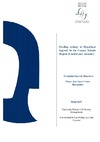Identificador persistente para citar o vincular este elemento:
https://accedacris.ulpgc.es/jspui/handle/10553/74763
| Campo DC | Valor | idioma |
|---|---|---|
| dc.contributor.advisor | Castro Hernández, José Juan | - |
| dc.contributor.author | García Marrero, Arminda | - |
| dc.date.accessioned | 2020-10-15T08:59:38Z | - |
| dc.date.available | 2020-10-15T08:59:38Z | - |
| dc.date.issued | 2017 | en_US |
| dc.identifier.uri | https://accedacris.ulpgc.es/handle/10553/74763 | - |
| dc.description.abstract | Lanternfishes are the mesopelagic community most abundant worldwide, such as Hygophum hygomii, which performs extensive diel migrations across the water column, between the surface to 1000 m of depth, interacting with plankton and micronekton at multiple depths, and generally feeding in the epipelagic layers at night. The diet composition was determined for juvenile and adult individuals, but also by sex, from samples obtained during cruises done by the B/E “La Bocaina” off the Canary Islands (Central-East Atlantic) from 1997 to 2002. A diet shift towards larger prey was evident from juveniles to adult individuals, at the time that ontogenetic changes occur in the relationship between head and body lengths, and it is probably associated to a change of habitat and/or a larger vertical migration. Hygophum hygomii showed a positive selection for copepods, but also they fed on mysids, euphausiids, decapod larvae, and other zooplankton components (such as chaetognats, amphipods, polychaetes, isopods, fishes, and gastropods larvae). Knowledge about H. hygomii ´s life story will provide information not only as a potential exploitable resource, but also for a better understanding of the pelagic ecosystem. | en_US |
| dc.language | eng | en_US |
| dc.subject | 2401 Biología animal (zoología) | en_US |
| dc.subject | 3105 Peces y fauna silvestre | en_US |
| dc.subject.other | Mesopelagic fishes | en_US |
| dc.subject.other | Myctophidae | en_US |
| dc.subject.other | Hygophum hygomii | en_US |
| dc.subject.other | Canary Islands | en_US |
| dc.subject.other | Diet composition | en_US |
| dc.title | Feeding ecology of "Hygophum hygomii" in the Canary Islands Region (Central-east Atlantic) | en_US |
| dc.type | info:eu-repo/semantics/masterThesis | en_US |
| dc.type | MasterThesis | en_US |
| dc.contributor.departamento | Biología | en_US |
| dc.contributor.facultad | Facultad de Ciencias del Mar | en_US |
| dc.investigacion | Ciencias | en_US |
| dc.type2 | Trabajo final de máster | en_US |
| dc.description.notas | Máster en Gestión Sostenible de Recursos Pesqueros ; 2016-2017 | en_US |
| dc.utils.revision | Sí | en_US |
| dc.identifier.matricula | TFT-42310 | es |
| dc.identifier.ulpgc | Sí | en_US |
| dc.contributor.buulpgc | BU-BAS | en_US |
| dc.contributor.titulacion | Máster Universitario en Gestión Sostenible de Recursos Pesqueros | es |
| item.fulltext | Con texto completo | - |
| item.grantfulltext | restricted | - |
| crisitem.advisor.dept | GIR ECOAQUA: Biodiversidad y Conservación | - |
| crisitem.advisor.dept | IU de Investigación en Acuicultura Sostenible y Ec | - |
| crisitem.advisor.dept | Departamento de Biología | - |
| Colección: | Trabajo final de máster | |
Visitas
70
actualizado el 06-ene-2024
Descargas
7
actualizado el 06-ene-2024
Google ScholarTM
Verifica
Comparte
Exporta metadatos
Los elementos en ULPGC accedaCRIS están protegidos por derechos de autor con todos los derechos reservados, a menos que se indique lo contrario.
